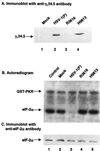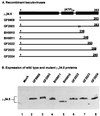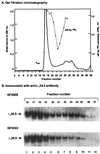AlaArg motif in the carboxyl terminus of the gamma(1)34.5 protein of herpes simplex virus type 1 is required for the formation of a high-molecular-weight complex that dephosphorylates eIF-2alpha
- PMID: 11264356
- PMCID: PMC114858
- DOI: 10.1128/JVI.75.8.3666-3674.2001
AlaArg motif in the carboxyl terminus of the gamma(1)34.5 protein of herpes simplex virus type 1 is required for the formation of a high-molecular-weight complex that dephosphorylates eIF-2alpha
Abstract
The gamma(1)34.5 protein of herpes simplex virus (HSV) type 1 functions to prevent the shutoff of protein synthesis mediated by the double-stranded-RNA-dependent protein kinase PKR. This is because gamma(1)34.5 associates with protein phosphatase 1 (PP1) through its carboxyl terminus, forming a high-molecular-weight complex that dephosphorylates the alpha subunit of translation initiation factor eIF-2 (eIF-2alpha). Here we show that Val193Glu and Phe195Leu substitutions in the PP1 signature motif of the gamma(1)34.5 protein abolished its ability to redirect PP1 to dephosphorylate eIF-2alpha and replication of mutant viruses was severely impaired. The gamma(1)34.5 protein, when expressed in Sf9 cells using a recombinant baculovirus, was capable of directing specific eIF-2alpha dephosphorylation. Deletions of amino acids 258 to 263 had no effect on activity of gamma(1)34.5. However, deletions of amino acids 238 to 258 abolished eIF-2alpha phosphatase activity but not PP1 binding activity. Interestingly, deletions in the AlaArg motif of the carboxyl terminus disrupted the high-molecular-weight complex that is required for dephosphorylation of eIF-2alpha. These results demonstrate that gamma(1)34.5 is functionally active in the absence of any other HSV proteins. In addition to a PP1 binding domain, the carboxyl terminus of gamma(1)34.5 contains an effector domain that is required to form a functional complex.
Figures








Similar articles
-
Dephosphorylation of eIF-2alpha mediated by the gamma(1)34.5 protein of herpes simplex virus type 1 is required for viral response to interferon but is not sufficient for efficient viral replication.J Virol. 2003 Sep;77(18):10154-61. doi: 10.1128/jvi.77.18.10154-10161.2003. J Virol. 2003. PMID: 12941928 Free PMC article.
-
Amino acid substitutions in the effector domain of the gamma(1)34.5 protein of herpes simplex virus 1 have differential effects on viral response to interferon-alpha.Virology. 2003 Mar 15;307(2):290-300. doi: 10.1016/s0042-6822(02)00075-2. Virology. 2003. PMID: 12667799
-
The gamma(1)34.5 protein of herpes simplex virus 1 complexes with protein phosphatase 1alpha to dephosphorylate the alpha subunit of the eukaryotic translation initiation factor 2 and preclude the shutoff of protein synthesis by double-stranded RNA-activated protein kinase.Proc Natl Acad Sci U S A. 1997 Feb 4;94(3):843-8. doi: 10.1073/pnas.94.3.843. Proc Natl Acad Sci U S A. 1997. PMID: 9023344 Free PMC article.
-
HSV gene functions: what have we learned that could be generally applicable to its near and distant cousins?Acta Virol. 1999 Apr-Jun;43(2-3):75-80. Acta Virol. 1999. PMID: 10696424 Review.
-
Neutralizing innate host defenses to control viral translation in HSV-1 infected cells.Int Rev Immunol. 2004 Jan-Apr;23(1-2):199-220. doi: 10.1080/08830180490265600. Int Rev Immunol. 2004. PMID: 14690861 Review.
Cited by
-
Replication of herpes simplex virus 1 depends on the gamma 134.5 functions that facilitate virus response to interferon and egress in the different stages of productive infection.J Virol. 2004 Jul;78(14):7653-66. doi: 10.1128/JVI.78.14.7653-7666.2004. J Virol. 2004. PMID: 15220440 Free PMC article.
-
HSV targeting of the host phosphatase PP1α is required for disseminated disease in the neonate and contributes to pathogenesis in the brain.Proc Natl Acad Sci U S A. 2015 Dec 15;112(50):E6937-44. doi: 10.1073/pnas.1513045112. Epub 2015 Nov 30. Proc Natl Acad Sci U S A. 2015. PMID: 26621722 Free PMC article.
-
Dephosphorylation of eIF-2alpha mediated by the gamma(1)34.5 protein of herpes simplex virus type 1 is required for viral response to interferon but is not sufficient for efficient viral replication.J Virol. 2003 Sep;77(18):10154-61. doi: 10.1128/jvi.77.18.10154-10161.2003. J Virol. 2003. PMID: 12941928 Free PMC article.
-
Functional interaction between fluorodeoxyuridine-induced cellular alterations and replication of a ribonucleotide reductase-negative herpes simplex virus.J Virol. 2001 Aug;75(15):7050-8. doi: 10.1128/JVI.75.15.7050-7058.2001. J Virol. 2001. PMID: 11435585 Free PMC article.
-
Virus-induced ER stress and the unfolded protein response.Front Plant Sci. 2012 Dec 28;3:293. doi: 10.3389/fpls.2012.00293. eCollection 2012. Front Plant Sci. 2012. PMID: 23293645 Free PMC article.
References
-
- Aitken A, Cohen P. Isolation and characterisation of active fragments of protein phosphatase inhibitor-1 from rabbit skeletal muscle. FEBS Lett. 1982;147:54–58. - PubMed
Publication types
MeSH terms
Substances
Grants and funding
LinkOut - more resources
Full Text Sources
Molecular Biology Databases

